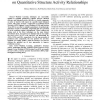154 search results - page 29 / 31 » Splice Site Prediction Using Artificial Neural Networks |
CIBCB
2009
IEEE
13 years 8 months ago
2009
IEEE
Machine Learning techniques are successfully applied to establish quantitative relations between chemical structure and biological activity (QSAR), i.e. classify compounds as activ...
JBCB
2007
13 years 7 months ago
2007
Mechanistic models for transcriptional regulation are derived using the methods of equilibrium statistical mechanics, to model equilibrating processes that occur at a fast time sc...
BMCBI
2008
13 years 7 months ago
2008
Background: T-cell epitopes that promiscuously bind to multiple alleles of a human leukocyte antigen (HLA) supertype are prime targets for development of vaccines and immunotherap...
IJCNN
2008
IEEE
14 years 1 months ago
2008
IEEE
— Hybrid intelligent systems (HIS) are very successful in tackling problems comprising of more than one distinct computational subtask. For instance, decision-making problems are...
CLUSTER
2007
IEEE
13 years 11 months ago
2007
IEEE
Abstract-- Multicore microprocessors have been largely motivated by the diminishing returns in performance and the increased power consumption of single-threaded ILP microprocessor...


